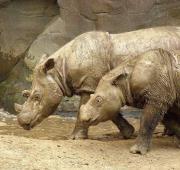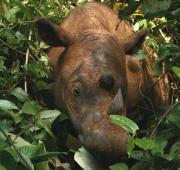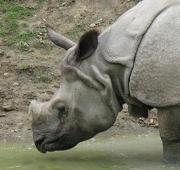 The Sumatran rhinoceros is the smallest of the five rhinoceros species with a body length of less than 250cm. Unlike the other Asian rhinoceros species, the Sumatran rhinoceros has two horns like the white and black rhinos found on the African continent.
The Sumatran rhinoceros is the smallest of the five rhinoceros species with a body length of less than 250cm. Unlike the other Asian rhinoceros species, the Sumatran rhinoceros has two horns like the white and black rhinos found on the African continent. The Sumatran rhinoceros primarily inhabits dense lowland rainforests, tall grass and reed beds that are plentiful with rivers, large floodplains, or wet areas with many mud wallows, swamps and cloud forests. The range of Sumatran rhinoceros once stretched from India, through south-east Asia and down to Sumatra but today, the Sumatran rhinoceros is only found on the islands of Sumatra and Borneo, with a number also on the Malaysian mainland.
The Sumatran rhinoceros primarily inhabits dense lowland rainforests, tall grass and reed beds that are plentiful with rivers, large floodplains, or wet areas with many mud wallows, swamps and cloud forests. The range of Sumatran rhinoceros once stretched from India, through south-east Asia and down to Sumatra but today, the Sumatran rhinoceros is only found on the islands of Sumatra and Borneo, with a number also on the Malaysian mainland.


The Sumatran rhinoceros is a herbivorous animal meaning that it sustains itself on a purely plant based diet. Sumatran rhinos browse the densely vegetated sub-tropical forest for leaves, flowers, buds, fruits, berries and roots which they dig up from the ground using their horns.
Due to it's large size, the Sumatran rhinoceros's only real predator in the wild are large wild cats such as tigers that will prey on the Sumatran rhino calves and weak individuals. Humans are the biggest threat to the Sumatran rhinoceros as they have been hunted to the brink of extinction for their horns.
The Sumatran rhinoceros is solitary animal and only comes together with other Sumatran rhinos to mate. The female Sumatran rhinoceros gives birth to a single calf after a gestation period that is over a year long. The Sumatran rhinoceros calf remains with it's mother until it is at least 2 years old and big enough to become independent.
Today, the Sumatran rhinoceros has been poached for it's horns to the extent that it is on the brink of extinction. Hunting of the Sumatran rhinoceros along with habitat loss in their native regions have led to there being estimated that there are less than 300 Sumatran rhinoceros individuals left in the jungles of south-east Asia today.

